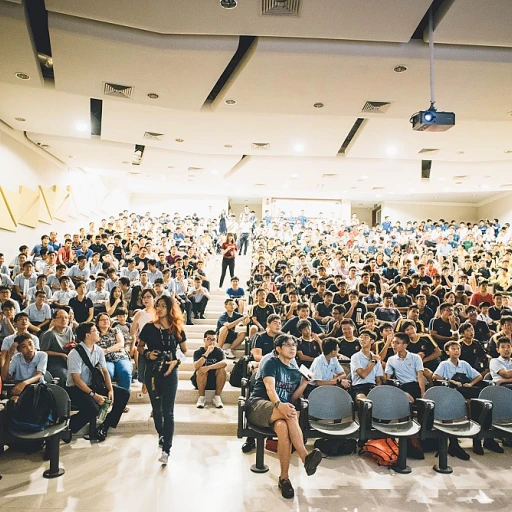
Understanding the Future Workforce Global Summit
Unveiling the Future Workforce Global Event
The Future Workforce Global Summit has become a pivotal event for those interested in understanding the changing dynamics of the workplace. Hosted on a global scale, this summit brings together an array of business leaders, human resources experts, and talent management professionals. It's far more than just a gathering; it's a strategic forum designed to explore the future of work and the management of human capital in an ever-evolving world.
Held in major business hubs like New York and Abu Dhabi, the summit draws influential figures and executive directors who are keen to share their insights on workforce development. Employing a combination of presentations, breakout sessions, and collaborative workshops, attendees gain valuable perspectives on leadership strategies and future workforce trends. The summit serves as a critical venue for executives and talent acquisition leaders to discuss innovative approaches to workforce management and skills development.
This unique event also provides an incredible opportunity for participants to delve into the latest developments in hive technology. Integrating this knowledge into future work strategies can prove instrumental in nurturing distributed workforce models and capital management tactics.
In essence, the Future Workforce Global Summit is a cornerstone event for anyone eager to gain a competitive edge in talent acquisition and human resource management, laying the groundwork for effective future workforce strategies. It creates a platform where the synthesis of ideas transcends the typical view of business development, propelling attendees toward a comprehensive understanding of future work dynamics.
Key Trends Shaping Work Tech
Adapting to Technological Innovation: Trends to Watch
The Future Workforce Global Summit was a hotbed of engaging discussions on the latest trends shaping work tech and its implications for workforce development. As organizations strive to remain competitive in the global economy, understanding these trends is paramount for leaders in business and human resources. In today's rapidly evolving landscape, here are some pivotal trends defining the work tech arena:- Distributed Workforce: With remote work becoming the norm, businesses are adapting to manage a distributed workforce efficiently. Strategies to ensure effective talent management and learning development are critical components for future work success.
- Human Capital Management: Leveraging technology for improved human capital management is gaining momentum. From talent acquisition to workforce development, integrating advanced tools helps in aligning with organizational goals and enhancing human resources function.
- Skills and Talent Development: As work profiles evolve, there's a growing emphasis on skills and development. This shift necessitates a focus on continuous learning and adapting to new technologies to equip leaders and future workforce with necessary competencies.
- Executive Leadership and Management: The role of executive directors and leadership teams is becoming more crucial than ever. By adopting innovative management practices, they can lead businesses to navigate through technological transformations.
Challenges Facing Work Tech Adoption
Overcoming Barriers to Work Tech Integration
The transition into a work tech-driven world is not without its hurdles. One of the main challenges businesses face is effectively integrating technology into existing workforce models. Despite numerous innovations showcased at global summits, real-world implementation can lag due to various factors including resistance to change and the lack of skilled personnel in technology adoption. This gap highlights the need for comprehensive workforce development that fosters digital literacy and adaptability within human resources.
Another significant issue is the management of a distributed workforce. With remote work gaining traction, leaders are required to rethink traditional management strategies, which calls for a greater emphasis on talent management and learning development. Companies must balance between autonomy and guidance, ensuring that their workforce feels connected and motivated while working remotely. This shift demands that organizations invest in training leaders to embrace new leadership techniques and technologies.
Moreover, regulations and compliance present another layer of complexity. Emerging technologies often outpace regulatory frameworks, creating uncertainty and hesitance among business leaders. Organizations must stay informed about policy changes and engage with stakeholders to gain a clear understanding of compliance requirements. This proactive approach requires collaboration between executive directors and policymakers to create a supportive environment for technological transformation.
The challenge of future-proofing talent acquisition and management also demands attention. As businesses strive to maintain a competitive profile, there is an increasing need for integrating AI-driven solutions in their recruitment processes. Exploring the artificial intelligence transformation offers a glimpse into how technological advancements can streamline operations and enhance talent acquisition strategies.
By addressing these challenges, organizations can foster a resilient workforce equipped to tackle the demands of the future. Executive leaders play a pivotal role in bridging the gap between current capabilities and future needs, ensuring that human capital serves as a driving force for business growth in this era of rapid technological evolution.
Innovative Solutions Highlighted at the Summit
Highlighted Innovations in Work Tech
The Future Workforce Global Summit served as a pivotal platform to unveil innovative solutions transforming the work tech landscape. These groundbreaking developments aimed to address the evolving needs of talent management and workforce development, crucial for human capital optimization. During various breakout sessions, industry leaders and executives showcased technologies that are shaping the future of work. One such innovation was the integration of distributed workforce management tools, designed to facilitate seamless communication and productivity across global teams. These tools are critical as businesses increasingly embrace hybrid models, allowing for more flexible work environments. Additionally, the summit highlighted advancements in learning and development platforms. These are tailored to meet the dynamic requirements of workforce skills acquisition, equipping employees with the competencies necessary for success in a rapidly changing business environment. The focus on talent acquisition strategies, coupled with enhanced analytics capabilities, underscores the necessity of aligning human resources with organizational goals. Industry leaders emphasized the importance of data-driven decision-making in talent management. They shared insights into how businesses can leverage data to view talent profiles holistically, thereby ensuring a proactive approach to workforce development. These strategies are not just theoretical but are being executed globally, as evidenced by the discussions led by executive directors and clinical professors from renowned institutions. The summit also shed light on cutting-edge tools that streamline human resources and capital management. These tools aim to reduce administrative burdens, allowing HR leaders to concentrate on strategic initiatives that foster innovation and growth. For those interested in deeper insights into these developments, further information can be found in detailed reports and case studies presented by summit participants. In summary, the innovations presented at the Future Workforce Global Summit are reflective of a broader commitment to leveraging technology for workforce enhancement. These solutions are not only shaping the work tech landscape but also setting precedents for future workforce strategies globally. As businesses seek to remain competitive, adopting such innovative approaches will be crucial in redefining success in the world of work.The Role of Policy and Regulation
The Influence of Policy and Regulation on Work Tech Advancements
The rapid progression of work tech innovations demands a strong partnership between regulatory bodies and technology leaders. At the Future Workforce Global Summit, discussions centered around how policy can shape, support, and sometimes hinder the integration of emerging work tech solutions. The role of policy-making becomes critical as it seeks to bridge the gap between technological advancements and workforce development. The adoption of new work technologies often requires reshaping existing frameworks and regulations to accommodate the needs of a distributed workforce or a shift toward human capital-centric operations. Leaders and executives in the field of talent management stress that effective regulations must support innovation without compromising workforce development and business ethics. Regulations and policies need to evolve to address several key concerns:- Data Privacy and Security: Ensuring that workforce data is protected is paramount as new technologies are increasingly reliant on data analytics for talent acquisition and management.
- Fair Labor Practices: With the introduction of AI and automation, policies must ensure that talent, whether human resources or automated systems, is managed ethically.
- Workforce Skill Development: Policies should emphasize continuous learning development opportunities to help workers adapt to tech transformations swiftly, maintaining their value in the global talent pool.












